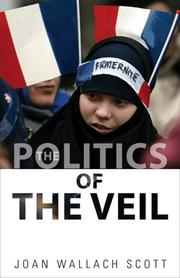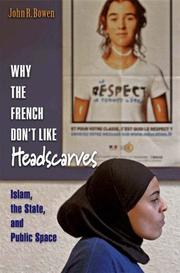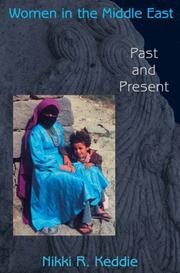| Listing 1 - 4 of 4 |
Sort by
|

ISBN: 9780691125435 9780691147987 0691147981 0691125430 Year: 2007 Publisher: Princeton Princeton university press
Abstract | Keywords | Export | Availability | Bookmark
 Loading...
Loading...Choose an application
- Reference Manager
- EndNote
- RefWorks (Direct export to RefWorks)
Muslims --- Islamophobia --- Racism --- Hijab (Islamic clothing) --- Secularism --- Culture conflict --- Musulmans --- Islamophobie --- Racisme --- Hijab --- Sécularisation --- Conflit culturel --- Law and legislation --- Cultural assimilation --- Droit --- Acculturation --- Cultural conflict --- Culture wars --- Conflict of cultures --- Intercultural conflict --- Social conflict --- Mohammedans --- Moors (People) --- Moslems --- Muhammadans --- Musalmans --- Mussalmans --- Mussulmans --- Mussulmen --- Religious adherents --- Islam --- Head scarves, Islamic --- Head scarves, Muslim --- Headscarves, Islamic --- Headscarves, Muslim --- Islamic head scarves --- Islamic headscarves --- Islamic scarves --- Muslim head scarves --- Muslim headscarves --- Muslim scarves --- Scarves, Islamic --- Scarves, Muslim --- Islamic clothing and dress --- Muslim women --- Burqas (Islamic clothing) --- Kerchiefs --- Purdah --- Veils --- Anti-Islam prejudice --- Anti-Islamism --- Anti-Muslim prejudice --- Anti-Muslimism --- Discrimination against Muslims --- Ethnic relations --- Prejudices --- Muslims in France --- Clothing --- Ḥijāb --- Sécularisation --- Islamophobia - France --- Racism - France --- Hijab (Islamic clothing) - Law and legislation - France --- Muslims - Cultural assimilation - France --- Secularism - France --- Culture conflict - France

ISBN: 1282964712 9786612964718 1400837561 9781400837564 0691125066 9780691125060 9780691138398 0691138397 Year: 2007 Publisher: Princeton Princeton University Press
Abstract | Keywords | Export | Availability | Bookmark
 Loading...
Loading...Choose an application
- Reference Manager
- EndNote
- RefWorks (Direct export to RefWorks)
The French government's 2004 decision to ban Islamic headscarves and other religious signs from public schools puzzled many observers, both because it seemed to infringe needlessly on religious freedom, and because it was hailed by many in France as an answer to a surprisingly wide range of social ills, from violence against females in poor suburbs to anti-Semitism. Why the French Don't Like Headscarves explains why headscarves on schoolgirls caused such a furor, and why the furor yielded this law. Making sense of the dramatic debate from his perspective as an American anthropologist in France at the time, John Bowen writes about everyday life and public events while also presenting interviews with officials and intellectuals, and analyzing French television programs and other media. Bowen argues that the focus on headscarves came from a century-old sensitivity to the public presence of religion in schools, feared links between public expressions of Islamic identity and radical Islam, and a media-driven frenzy that built support for a headscarf ban during 2003-2004. Although the defense of laïcité (secularity) was cited as the law's major justification, politicians, intellectuals, and the media linked the scarves to more concrete social anxieties--about "communalism," political Islam, and violence toward women. Written in engaging, jargon-free prose, Why the French Don't Like Headscarves is the first comprehensive and objective analysis of this subject, in any language, and it speaks to tensions between assimilation and diversity that extend well beyond France's borders.
Islam and secularism --- Clothing and dress --- Muslim women --- Veils --- Hijab (Islamic clothing) --- Secularism and Islam --- Secularism --- Apparel --- Clothes --- Clothing --- Clothing and dress, Primitive --- Dress --- Dressing (Clothing) --- Garments --- Beauty, Personal --- Manners and customs --- Fashion --- Undressing --- Islamic women --- Women, Muslim --- Women --- Headgear --- Head scarves, Islamic --- Head scarves, Muslim --- Headscarves, Islamic --- Headscarves, Muslim --- Islamic head scarves --- Islamic headscarves --- Islamic scarves --- Muslim head scarves --- Muslim headscarves --- Muslim scarves --- Scarves, Islamic --- Scarves, Muslim --- Islamic clothing and dress --- Burqas (Islamic clothing) --- Kerchiefs --- Purdah --- Political aspects --- Religious aspects --- Islam. --- Social aspects --- France --- Race relations. --- #SBIB:316.331H384 --- #SBIB:316.331H421 --- #SBIB:328H212 --- #SBIB:39A10 --- 081 Godsdienst --- 668.5 Migrantenvrouwen --- 734 Multicultureel onderwijs --- Frankrijk --- Hoofddoek --- Islam --- Religious aspects&delete& --- Geografische spreiding van de godsdiensten: Europa --- Morfologie van de godsdiensten: Islam --- Instellingen en beleid: Frankrijk --- Antropologie: religie, riten, magie, hekserij --- Muslims --- Laicism --- Cultural assimilation --- Race relations --- FRANCE -- 29 --- HIJAB -- 29 --- CLOTHING AND DRESS -- 29 --- Hijab (Islamic clothing) - France --- Veils - Social aspects - France --- Muslim women - France - Clothing --- Muslims - France - Cultural assimilation --- Clothing and dress - Religious aspects - Islam --- Clothing and dress - Political aspects - France --- Islam and secularism - France --- Laicism - France --- France - Race relations --- Muslimahs

ISBN: 052187064X 9780521870641 9780511487965 9780521187381 9780511261503 0511261500 0511487967 0511259735 9780511259739 0511260938 9780511260933 9780511260384 0511260385 0521187389 1107171741 1280749482 0511320442 Year: 2007 Volume: 139 Publisher: Cambridge, U.K. New York Cambridge University Press
Abstract | Keywords | Export | Availability | Bookmark
 Loading...
Loading...Choose an application
- Reference Manager
- EndNote
- RefWorks (Direct export to RefWorks)
In this 2006 text, Daniel M. Gurtner examines the meaning of the rending of the veil at the death of Jesus in Matthew 27:51a by considering the functions of the veil in the Old Testament and its symbolism in Second Temple and Rabbinic Judaism. Gurtner incorporates these elements into a compositional exegesis of the rending text in Matthew. He concludes that the rending of the veil is an apocalyptic assertion like the opening of heaven revealing, in part, end-time images drawn from Ezekiel 37. Moreover, when the veil is torn Matthew depicts the cessation of its function, articulating the atoning role of Christ's death which gives access to God not simply in the sense of entering the Holy of Holies (as in Hebrews), but in trademark Matthean Emmanuel Christology: 'God with us'. This underscores the significance of Jesus' atoning death in the first gospel.
Veil of the Temple (Jerusalem) --- Bible. --- Bible. N.T. Evangiles. Matthieu (anglais). 2007. Gurtner, D. --- 226.2 --- 225*5 --- Curtain of the Temple (Jerusalem) --- Inner Veil of the Temple (Jerusalem) --- Parokhet (Jerusalem) --- Temple Curtain (Jerusalem) --- Temple Veil (Jerusalem) --- Draperies --- Evangelie volgens Matteüs --- Laatste avondmaal. Proces van Jezus. Lijden. Kruisiging --- 225*5 Laatste avondmaal. Proces van Jezus. Lijden. Kruisiging --- Veils. --- Headgear --- Hijab (Islamic clothing) --- Bible --- Evangelie volgens Matteus --- Evangelie volgens Matthéüs --- Matʻae pogŭm --- Matai den --- Matai ni yoru fukuinsho --- Matius (Book of the New Testament) --- Mattá --- Matteo (Book of the New Testament) --- Matteus --- Matthäusevangelium --- Matthéüs --- Matthew (Book of the New Testament) --- Matthieu (Book of the New Testament) --- Criticism, interpretation, etc. --- Arts and Humanities --- Religion

ISBN: 0691128634 1283540010 9786613852465 140084505X 0691116105 9780691128634 9780691116105 Year: 2007 Publisher: Princeton Princeton University Press
Abstract | Keywords | Export | Availability | Bookmark
 Loading...
Loading...Choose an application
- Reference Manager
- EndNote
- RefWorks (Direct export to RefWorks)
Written by a pioneer in the field of Middle Eastern women's history, Women in the Middle East is a concise, comprehensive, and authoritative history of the lives of the region's women since the rise of Islam. Nikki Keddie shows why hostile or apologetic responses are completely inadequate to the diversity and richness of the lives of Middle Eastern women, and she provides a unique overview of their past and rapidly changing present. The book also includes a brief autobiography that recounts Keddie's political activism as one of the first women in Middle East Studies. Positioning women within their individual economic situations, identities, families, and geographies, Women in the Middle East examines the experiences of women in the Ottoman Empire and Turkey, in Iran, and in all the Arab countries. Keddie discusses the interaction of a changing Islam with political, cultural, and socioeconomic developments. In doing so, she shows that, like other major religions, Islam incorporated ideas and practices of male superiority but also provoked challenges to them. Keddie breaks with notions of Middle Eastern women as faceless victims, and assesses their involvement in the rise of modern nationalist, socialist, and Islamist movements. While acknowledging that conservative trends are strong, she notes that there have been significant improvements in Middle Eastern women's suffrage, education, marital choice, and health.
Feminism --- Women --- History. --- Political philosophy. Social philosophy --- Islam --- Sexology --- Community organization --- Sociology of the family. Sociology of sexuality --- Middle East --- Cylinder seals --- Symbolism --- History --- Femmes --- Féminisme --- Histoire --- Moyen-Orient --- #SBIB:316.346H20 --- #SBIB:39A77 --- Emancipation of women --- Feminist movement --- Women's lib --- Women's liberation --- Women's liberation movement --- Women's movement --- Social movements --- Anti-feminism --- Positie van de vrouw in de samenleving: algemeen --- Etnografie: Noord-Afrika en het Midden-Oosten --- Emancipation --- Abbasid Caliphate. --- Adultery. --- Afghanistan. --- Agriculture (Chinese mythology). --- Algeria. --- Arabs. --- Caliphate. --- Cambridge University Press. --- Carpet. --- Child custody. --- Colonialism. --- Concubinage. --- Doria Shafik. --- Dower. --- Employment. --- Extended family. --- Family planning. --- Female education. --- Feminism (international relations). --- Feminism. --- Feminist movement. --- Gender equality. --- Gender inequality. --- Gender role. --- Hadith. --- Hijab. --- Homosexuality. --- Honor killing. --- Household. --- Human female sexuality. --- Husain. --- Ideology. --- Imperialism. --- Institution. --- Iranian Revolution. --- Islam. --- Islamic Modernism. --- Islamism. --- Janet Afary. --- Jews. --- Leila Ahmed. --- Lila Abu-Lughod. --- Literacy. --- Literature. --- Mahnaz Afkhami. --- Middle East. --- Missionary. --- Muhammad's wives. --- Muslim world. --- Muslim. --- Narrative. --- Newspaper. --- Nikki Keddie. --- North Africa. --- Oppression. --- Orientalism. --- Ottoman Empire. --- Patriarchy. --- Politician. --- Politics. --- Polygamy. --- Pre-Islamic Arabia. --- Prejudice. --- Prostitution. --- Quran. --- R. --- Religion. --- Reza Shah. --- Ruhollah Khomeini. --- Safavid dynasty. --- Saudi Arabia. --- Sayyid. --- Seclusion. --- Secularism. --- Sex segregation. --- Sharia. --- Slavery. --- Social science. --- Sunni Islam. --- Syracuse University Press. --- The Other Hand. --- Tradition. --- Tunisia. --- University of California Press. --- Upper class. --- Veil. --- Virginity. --- Warfare. --- Western world. --- Westernization. --- Women in Arab societies. --- Women in Islam. --- Women's history. --- Women's rights. --- Women's suffrage. --- World War I. --- World War II. --- Writing. --- Yale University Press. --- Ziba Mir-Hosseini. --- Nationalism --- Sexuality --- Women's movements --- Book
| Listing 1 - 4 of 4 |
Sort by
|

 Search
Search Feedback
Feedback About UniCat
About UniCat  Help
Help News
News